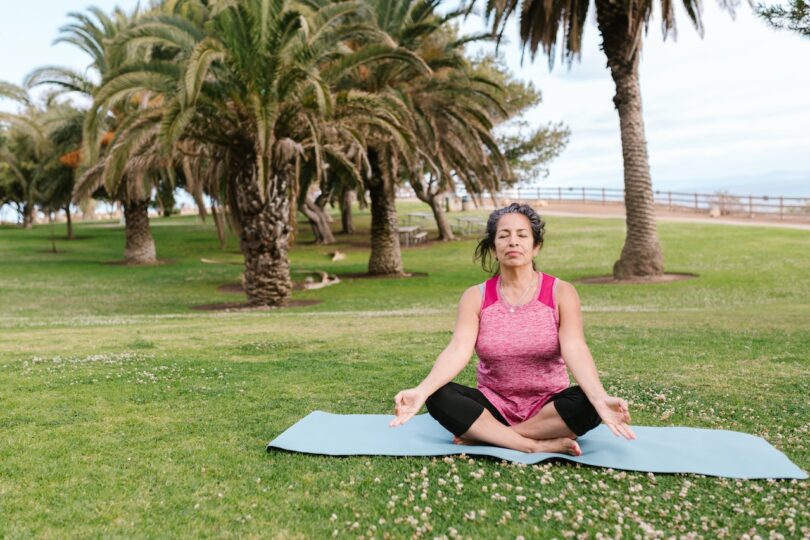Yoga and Blood Pressure Management
Yoga, an ancient practice, is now recognized for its potential in enhancing overall health and addressing hypertension. Scientific evidence has emerged, spotlighting yoga as a complementary tool for reducing high blood pressure. This article will examine the link between yoga and blood pressure reduction, offering practical advice on integrating yoga into your daily routine. With centuries of practice behind it, yoga’s popularity as a holistic approach to well-being continues to grow, making it a promising addition to hypertension management strategies. Embracing yoga may pave the way for improved health and a more balanced lifestyle.
Understanding High Blood Pressure: Causes and Consequences
High blood pressure is a widespread concern with grave health implications like heart disease, stroke, and kidney issues, impacting countless individuals globally. Stress, unhealthy diet, sedentary habits, and genetic factors play significant roles in its development. To grasp the potential advantages of yoga in daily life, it’s vital to comprehend the roots and repercussions of hypertension. By recognizing the factors that contribute to high blood pressure, we can appreciate yoga’s potential as a valuable addition to hypertension management. Embracing yoga may aid in mitigating risks and promoting overall well-being, offering a holistic approach to combat this prevalent health condition.
The Link between Yoga and Blood Pressure Reduction
Numerous studies have demonstrated the positive impact of regular yoga practice on reducing blood pressure levels. Yoga’s holistic approach, integrating physical postures, breath control techniques, and meditation, targets the root causes of hypertension. Through relaxation and stress reduction, yoga improves circulation and enhances cardiovascular health. The combination of mindful movement and focused breathing regulates the autonomic nervous system, leading to decreased sympathetic activity and increased parasympathetic response, ultimately lowering blood pressure. Additionally, yoga’s influence on weight management and improved endothelial function further contributes to its beneficial effects. Embracing yoga as a complementary approach may empower individuals in their journey to maintain healthy blood pressure levels and overall well-being.
The Science Behind Yoga’s Impact on Blood Pressure
Scientific research has shed light on the physiological mechanisms underlying yoga’s positive impact on blood pressure. Consistent yoga practice leads to reduced sympathetic nervous system activity, decreased heart rate, improved endothelial function, and lower inflammation levels. These combined effects work harmoniously to bring blood pressure into a healthier range. Understanding the scientific basis for yoga’s influence on blood pressure strengthens our confidence in its effectiveness as a complementary approach to hypertension management. By addressing multiple contributing factors, yoga offers a holistic and evidence-based method to promote cardiovascular health and overall well-being, making it a valuable addition to blood pressure management strategies.
Yoga Poses for Lowering Blood Pressure: Gentle Asanas
For individuals with high blood pressure, specific yoga postures, or asanas, offer particular benefits. Gentle poses like Child’s Pose (Balasana), Legs-Up-the-Wall Pose (Viparita Karani), and Corpse Pose (Savasana) promote relaxation, calming the body and mind. These asanas enhance circulation, release tension, and facilitate blood pressure reduction. By incorporating these poses into your yoga practice regularly, you can experience significant benefits. Embracing these gentle and soothing postures may play a crucial role in managing hypertension, contributing to an overall sense of well-being and promoting cardiovascular health. Always consult with a healthcare professional before starting any new exercise regimen, especially if you have underlying health conditions.
Breath Control Techniques: Pranayama for Blood Pressure Regulation
Pranayama, the practice of controlled breathing, is a fundamental aspect of yoga that offers powerful tools for blood pressure management. Techniques like Deep Abdominal Breathing, Alternate Nostril Breathing (Nadi Shodhana), and Bee Breath (Bhramari Pranayama) have shown to activate the parasympathetic nervous system, reducing stress and promoting relaxation. Integrating pranayama into your yoga routine can help regulate blood pressure levels.
Meditation and Mindfulness: Enhancing the Benefits of Yoga
Meditation and mindfulness practices complement yoga in promoting blood pressure reduction. Mindful awareness and focused attention help cultivate a calm and balanced state of mind, reducing stress and anxiety that can contribute to hypertension. Incorporating meditation into your yoga practice enhances the overall benefits and supports long-term blood pressure management.
Yoga and Lifestyle Modifications: A Comprehensive Approach
Yoga is most effective when combined with lifestyle modifications that support cardiovascular health. A well-balanced diet low in sodium, regular physical activity, stress management techniques, and adequate sleep are essential components of a comprehensive approach to blood pressure management. By incorporating these modifications along with a consistent yoga practice, you can optimize your overall well-being.
Related Article: Know About Hot Yoga Benefits
Incorporating Yoga into Daily Routine: Practical Tips and Guidelines
Integrating yoga into your daily routine doesn’t have to be daunting. By starting gradually, setting realistic goals, and finding a style of yoga that suits your preferences and needs, you can establish a sustainable practice. This section provides practical tips and guidelines to help you make yoga an integral part of your daily life, ensuring long-term blood pressure management and overall health benefits.
Precautions and Modifications for Individuals with High Blood Pressure
While yoga is generally safe for most individuals, it is essential to take certain precautions if you have high blood pressure. Understanding contraindicated poses and practicing under the guidance of a qualified yoga instructor can help ensure your safety. This section outlines specific modifications and precautions to consider, empowering you to practice yoga safely and effectively.
Personal Stories: Testimonials of Individuals Benefiting from Yoga
Real-life experiences can offer inspiration and motivation for those considering yoga as a means to manage their blood pressure. In this section, we share personal stories and testimonials from individuals who have successfully incorporated yoga into their lives and experienced positive changes in their blood pressure levels. These stories provide encouragement and highlight the transformative power of yoga.
Conclusion:
In conclusion, yoga presents a holistic and effective approach to managing high blood pressure. By incorporating gentle asanas, breath control techniques, meditation, and mindfulness into your routine, you can promote cardiovascular health and reduce blood pressure levels. Combine these practices with lifestyle modifications, take necessary precautions, and seek guidance from experts when needed. Embrace the transformative power of yoga and embark on a journey toward optimal blood pressure management and overall well-being.
Related Article: Morning Yoga For Weight Loss







